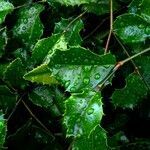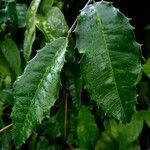Trees or shrubs; dioecious. Bark grayish white, smooth. Branchlets angular; spines straight, 1-1.5(-4.5) cm. Stipules tapered, ca. 5 mm. Petiole ca. 4 mm; leaf blade rhombic to oblong-obovate, 1-4.5(-9) × 0.6-2.5(-5) cm, thickly leathery, abaxially with cystoliths, adaxially glabrous and shiny, base cuneate to decurrent, margin loosely revolute with 5 or fewer spiny teeth, apex acute, blunt, or retuse, with two spiny teeth; midvein conspicuous on both surfaces and abaxially prominent, secondary veins pinnate, abaxially inconspicuous, and adaxially slightly depressed. Bisexual inflorescences absent. Male inflorescences axillary, spicate, 0.5-1.2(-5) cm; bracts conspicuous, imbricate, margin dark. Female inflorescences shortly spicate, 2-6-flowered. Male flowers: shortly pedicellate; calyx lobes 4, ± orbicular, margin inflexed and ciliate; pistillode 3-5-branched. Female flowers: calyx lobes 4, outer 2 smaller; ovary oblique. Drupes on brachyblasts, oblate, ca. 1 cm in diam., with persistent bracts, half enclosed by persistent calyx lobes. Fl. Apr, fr. May-Jun.
A small tree. It grows 10 m tall. The bark is greyish-white and smooth. The small branches are angular and have spines. These are 1-2 cm long. The leaves are oval and 1-5 cm long by up to 3 cm wide. The edges can curve back and have spiny teeth. The ripe fruit are black. They are 1 cm across.



